Social Robots in Early Motor Interventions
and Beyond
Speaker: Dr. Naomi Fitter
Oregon State University, OR, USA
Theme: robotics, social robots
--------------------------------------------
Time: 2023-Sept-22, 1:00 pm – 2:00 pm
Zoom Meeting ID: 966 7094 8019 (link) Passcode: MME2022
Summary: As robots appear in more everyday environments, they will have new opportunities to enhance the lives of the people around them. One reason why this potential is exciting is that robots, compared to "non-embodied" technology solutions (such as a phone, smart watch, computer, or AI assistant), have been shown to be more motivating and peer-like. In challenging interaction scenarios such as encouraging physical activity or other healthy habits, this type of clout can make or break the success of a technology-based intervention. Within the realm of robot-mediated interventions itself, many additional aspects of robotic system design merit further attention to enhance the potential for success. For example, robots' natural sound profiles often include flaws that repel users, and robots have a bad sense of humor. My research group is dedicated to better understanding nonverbal (and comedy-based verbal) robot expression, and designing effective tools for improving and effectively leveraging these communication modalities. To date, my research program has applied and thoroughly investigated one resulting family of assistive robots for early motor interventions in the child-robot interaction domain. We observed that these robots can successfully teach and reinforce particular types of movement (such as a leg-extension kick that is important for taking one's first steps), in addition to encouraging more physical activity than other intervention approaches. My ongoing and future research aims to create everyday robotic systems to help people live healthier and happier lives in additional intervention scenarios.
Dr. Naomi T. Fitter is an Assistant Professor in the School of Mechanical, Industrial, and Manufacturing Engineering at Oregon State University. Her past degrees include a B.S. and B.A. in mechanical engineering and Spanish from the University of Cincinnati and an M.S.E. and Ph.D. in robotics and mechanical engineering and applied mechanics from the University of Pennsylvania, and she completed her postdoctoral work at the University of Southern California. As a member of the Collaborative Robotics and Intelligent Systems (CoRIS) Institute, Dr. Fitter aims to equip robots with the ability to engage and empower people in interactions from playful high-fives to challenging physical therapy routines.
Please contact the host, Prof. Yue Hu (yue.hu@uwaterloo.ca), if any questions
HOW CAN INSECTS WALK UPSIDE-DOWN?
THE BIOMECHANICS OF BEETLE'S WET AND HAIRY ADHESIVE PADS
Speaker: Prof. Tristan Gilet
University of Liege, Belgium
Theme: Solids, materials, and Fluids
Time: 2023-Sept-12th, 11:00 am-12:00 pm ETD
Zoom Meeting ID: 789 699 0683 (link) Passcode: MME2023
Abstract: The miniaturization of pick-and-place robotics is currently limited by the challenge of controlling adhesion forces on a wide variety of substrates and on very short timescales. Insects have already solved this challenge: most of them can walk on about any surface in any orientation. Thanks to the adhesive pads on their tarsi, they generate appropriate adhesion and friction forces, and they can cancel them a fraction of a second later. This talk will be focused on the hairy pads of beetles. I will mainly discuss two ingredients that guarantee a robust, efficient, and controllable adhesion to different substrates: compliant microstructures (the hair tips), and the presence of a liquid secretion. I will first present in vivo experiments on the walk kinematics and mechanics of these hair tips. Our observations provide evidence that the secretion forms wedge-shaped liquid bridges between the compliant hair tips and the substrate. We could show that the hair tips are in elastocapillary equilibrium and that the negative relative pressure in the bridges provides a passive way of regulating the amount of secretion (and thereby the level of adhesion). In a second time, I will present experimental measurements on a scaled-up physical model of one hair tip. The net adhesive force generated through the interplay of capillary and elastic forces is measured as a function of the proximity of the hair to the surface. I will finally discuss a beam model that captures well the experimental data and provides further insights into the mechanical behavior of these wet hair tips.
Tristan Gilet obtained an MSc in Aerospace Engineering (ISAE, Toulouse) in 2004 and a MSc in Engineering Physics (ULiège) in 2005. He completed a PhD in Physics in 2009 (ULiège) on the dynamics of droplets in various contexts. He was then appointed as an instructor at the Dept. of Mathematics at MIT (Cambridge, MA) for two years. Since 2011, he is an assistant professor and the head of the Microfluidics Lab at the Department of Aerospace and Mechanical Engineering of the University of Liege (Belgium). The research of the Microfluidics Lab is focused on microscale flows involving surface tension, both in biological and engineering contexts. Current research projects mostly focus on drop impacts in various natural occurrences, droplet microfluidics, and centrifugal microfluidics.
Please contact the host, Prof. Zhao Pan (zhao.pan@uwaterloo.ca), if any questions
FLOW SEPARATION AND WIND ENERGY
Speaker: Prof. David Greenblatt
Technion – Israel Institute of Technology, Israel
Theme: Fluids, Thermal, and Solids
--------------------------------------------
Time: 2023-Aug-30, 10:00 am-11:00 pm ETD
E5-3052,Zoom Meeting ID: 978 4161 0594 (link) Passcode: 300636
Abstract: Flow separation from lifting surfaces is generally associated with performance losses resulting in decreased lift or increased drag. Hence, wind turbine designers strive to avoid blade separation in order to maximize wind turbine power. In contrast, our research exploits the management or control of separation for wind energy generation, with applications to horizontal axis wind turbines (HAWTs), vertical axis wind turbines (VAWTs) and vibrating wind energy harvesters (WEHs). On HAWTs, I will show how the forced variation of flow separation can be used to control power and loads under extreme changes in the relative velocity vector (magnitude and direction). On VAWTs, I will show how we design the turbine blades to stall dynamically, such that dynamic stall is responsible for energy generation. Finally, I will describe how we periodically control separation on bluff bodies to excite wake instabilities responsible for energy generation on vibrating WEHs.
David Greenblatt obtained his PhD at Tel Aviv University and conducted post-doctoral research at the Illinois Institute of Technology, NASA Langley Research Center and the Technical University of Berlin. He has authored or co-authored more than 170 publications, nine book chapters and eleven patents. He is presently a Professor at the Technion’s Faculty of Mechanical Engineering, Head of the Flow Control Laboratory, and the Energy Center. He is an Associate Fellow of the American Institute of Aeronautics and Astronautics.
Please contact the host, Prof. Zhao Pan (zhao.pan@uwaterloo.ca), if any questions
Multifunctional Materials and Composites Enabled by Additive Manufacturing and Nanoengineering
Speaker: Prof. Shanmugam Kumar
James Watt School of Engineering, University of Glasgow, UK
Theme: materials, additive manufacturing
--------------------------------------------
Time: 2023-Aug-9, 10:00 am – 11:00 am
Zoom Meeting ID: 966 7094 8019 (link) Passcode: MME2022
Summary: The emergence of micro-, nano-, and molecularly-tailored multimaterial systems, particularly those enabled by additive manufacturing (AM) technologies, facilitates the design of new and enhanced functionalities. Building from advances in various disciplines, including decades-long work on bulk microfiber heterogeneous composites, multimaterial and multifunctional 3D and 4D printing technologies offer the possibility of cost-effective automation of the fabrication process and provide greater flexibility for locally tailoring the material architecture and/or properties in three-dimensions. This talk will provide an overview of cross-disciplinary research activities of our group =: (i) tailored multilayers (compliance-tailoring, morphology-tailoring and surfacetailoring); (ii) nature-inspired materials (nacreous materials, and camouflage composites); (iii) nanocomposites and 4D printing (nano-biocomposites, piezoresistive self-sensing nanocomposites, and morphing structures); (iv) multiscale and multifunctional fiber composites (hierarchical/multiscale composites, and self-sensing cellular composites) and (v) architected materials and metamaterials (2D and 3D mechanical and multifunctional architected lattices for energy absorbing structures, smart medical devices, energy storage, thermal management, and EMI shields). Manipulating matter at relevant length scales, in 3D and 4D, enables strain-, stress-, and functional engineering towards enhanced performance, but also opens new opportunities in fabrication. The convergence of emerging micro- and nano-scale AM techniques, as well as the ability to design nano- and micro-architected hierarchical structures with more tightly controlled geometry, will allow the development of new classes of materials with unprecedented properties optimised for location-specific structural and/or functional requirements suitable for bio, defence, energy, automotive, and aerospace applications.
Prof. Kumar leads the Advanced Materials and 3D Printing Laboratory in the James Watt School of Engineering at the University of Glasgow. He obtained his Ph.D. in Solid Mechanics and Materials Engineering from the Department of Engineering Science, University of Oxford. His research interests revolve around mechanics, materials design & innovation, and additive manufacturing with a focus on multiscale and multifunctional attributes, towards energy efficient, sustainable, and decarbonising applications. His group’s strength in combining theory, simulations and experiments has led to several novel contributions. He has been awarded the ASPIRE Award for Research Excellence (AARE) thrice. He also serves on the editorial boards of Advanced Engineering Materials (Wiley), International Journal of Adhesion and Adhesives (Elsevier), Scientific Reports (Nature), and MetalMat (Wiley) Moreover, he serves as an Associate Editor for the Journal of Materials Engineering and Performance (Springer). He has edited a book and 2 Special Issues, contributed 7 book chapters, authored more than 100 journal articles, and is currently leading two Special Issue journal collections. He has advised/mentored over 45 higher degree research students (MS/PhD) and research staff (postdocs/research scientists) and delivered over 45 invited/keynote talks. Eleven of his mentees/students moved on to faculty positions at leading universities across the globe. He is a senior member of the AIAA, and a member of ASME, APS, ACS, MRS and Society for Adhesion and Adhesives, UK. Kumar serves on the ASME Structures and Materials TC. He has also held short visiting appointments at the University of Cambridge, MIT, and NTU Singapore, and has active collaborations around the world, including at the University of Cambridge, TAMU, UT Austin, Georgia Tech, Harvard Medical School, MIT, etc.
Please contact the host, Prof. Yue Hu (yue.hu@uwaterloo.ca), if any questions
Physical human-robot interaction: why and how?
Speaker: Dr. Marie Charbonneau
University of Calgary, AB, Canada
Time: 2023-July-28, 11:30 am - 12:30 pm
In person only seminar
Location: E5-2004
Light snacks will be served
Summary: Touch is a central component of humans' interactions with others and with the world. While robots are increasingly being developed to work alongside people, their capacity to interact with humans through touch is yet underdeveloped. This talk will explore why this may be the case, why it matters, and how robots can be made more physically interactive for better human-robot collaborations.
Dr. Marie Charbonneau works to make human-robot interactions safe, comfortable, and intuitive. Dr. Charbonneau received a Marie Skłodowska-Curie fellowship during her doctorate in Advanced and Humanoid Robotics from the Istituto Italiano di Tecnologia and the Università Degli Studi di Genova; she joined the University of Calgary as Assistant Professor in September 2021, following post-doctoral work in humanoid robotics at the University of Waterloo. Dr. Charbonneau’s work in whole-body control regulates the forces between robots and their environment, ensuring these powerful machines interact respectfully and reliably with people. For instance, she has programmed a humanoid robot to waltz with human partners, and she currently works on increasing a robot's awareness of physical contacts.
Note: this is an in person only seminar in E5-2004, light snacks will be served during the seminar
Please contact the host, Prof. Yue Hu (yue.hu@uwaterloo.ca), if any questions
Constructing Feedback Methods to increase Effectiveness and Equity
Speaker: Prof. Gordon G. Krauss
Harvey Mudd College, USA
Theme: Design
--------------------------------------------
Time: 2023-June-29, 1:00 pm – 2:00 pm
Attendance in person only in E5-2004
Summary: Design reviews are intended to provide critical feedback during a design process so that an improved artifact will be realized, and, in educational settings, so that the design process employed will be improved. Research indicates that student reviewers may be reticent to provide authentic feedback in a traditional question and answer format. This talk will describe a simple method that is effective in generating a greater quantity of comments in a more candid and open way preferred by designers and reviewers.
Feedback plays an important role in the design process. In formal design review situations, presenters receive and respond to questions from reviewers. It is hypothesized that structural and social barriers may complicate and degrade the feedback process. In this talk, the speaker examines the peer feedback process for the design reviews and culminating presentations of a preliminary conceptual design project in an introduction to design, manufacturing, and management course, E4, at Harvey Mudd College. Student design teams present their design process and the resulting design artifact to their class section. The other students in the section provide feedback to the team. Teams presented their design reviews as either live presentations or via video and were reviewed by teams through either live oral questions and answers or in written comments using a handwritten or online form. The specificity and motivation from the instructors for feedback also varied by section. The video section responded to evaluator comments in class and was able to receive clarification about the comments. The authors of this study are able to note the differences in quantity of feedback, the type of feedback, and the response to the feedback by the design teams. The study suggests that (1) students in this course may not be open with their feedback during oral question and answer periods, (2) that simple tools such as written feedback will gather more information than question and answer periods and (3) that class time may be used to discuss feedback rather than for presentations effectively to provide better feedback and interaction. Additional insight on the effectiveness of this technique with respect to gender differences and expectations regarding feedback will be discussed time permitting.
Prof. Gordon G. Krauss is the Fletcher Jones Professor of Engineering Design in the Department of Engineering at Harvey Mudd College. His design research interests include improving the way designers interact with each other in the design process and how design process tools are applied. Prior to joining Harvey Mudd College, Dr. Krauss was a lecturer in Mechanical Engineering at the University of Michigan and enjoyed a career in industry. He holds a Ph.D. in Mechanical Engineering, an M.S. in Aerospace Engineering, both from Boston University, and completed his undergraduate degree in Physics and Astronomy at Haverford College.
Please contact the host, Prof. Yue Hu (yue.hu@uwaterloo.ca), if any questions
Robot learning from few examples by exploiting the structure and geometry of data
Speaker: Dr. Sylvain Calinon
Idiap Research Institute & Ecole Polytechnique Fédérale de Lausanne (EPFL), Switzerland
Theme: Machine Learning, Robotics
--------------------------------------------
Time: 2023-July-10, 11:30 am - 12:30 pm
Zoom Meeting ID: 966 7094 8019 (link) Passcode: MME2022
Summary: The research in my group focuses on developing robot learning approaches that can rely on only few demonstrations or trials. The main challenge boils down to finding structures that can be used in a wide range of tasks, which requires us to advance research on several fronts, including (from low level to high level): Geometric structures, Data structures, Combination structures, and Learning structures, which I will discuss in my presentation.
The geometric structures relate to the use of Riemannian geometry and geometric algebra in robotics, where prior knowledge about the physical world can be embedded within the representations of skills and associated learning algorithms. The data structures relate to tensor factorization techniques, which can be used in global optimization problems to efficiently extract and compress information. The combination structures relate to movement primitive and control primitive representations in robotics, that can be embedded within optimal control problem formulations. The learning structures relate to meta-learning problems and interfaces to facilitate the programming and monitoring of manipulation tasks in robotics.
Dr. Sylvain Calinon is a Senior Research Scientist at the Idiap Research Institute and a Lecturer at the Ecole Polytechnique Fédérale de Lausanne (EPFL). He heads the Robot Learning & Interaction group at Idiap, with expertise in human-robot collaboration, robot learning from demonstration and model-based optimization. The approaches developed in his group can be applied to a wide range of applications requiring manipulation skills, with robots that are either close to us (assistive and industrial robots), parts of us (prosthetics and exoskeletons), or far away from us (shared control and teleoperation). Website: https://calinon.ch
Please contact the host, Prof. Yue Hu (yue.hu@uwaterloo.ca), if any questions.
HARNESSING THE ULTRAFAST DYNAMICS OF ACOUSTICALLY DRIVEN BUBBLES AND DROPLETS
Speaker: Prof. Outi Supponen
ETH Zurich, Switzerland
Theme: Fluids, Thermal, and Solids
--------------------------------------------
Time: 2023-June-29, 11:30 am-12:30 pm ETD
Zoom Meeting ID: 789 699 0683 (link) Passcode: MME2023
Abstract: Bubbles oscillate volumetrically under the effect of pressure fluctuations, such as those produced by underwater sound waves. When driven into a violent collapse, they can yield strong sound emissions, high-speed jets, and extreme heating – a behaviour known as cavitation. Here, we will present ongoing research efforts to reach a fundamental understanding of the intriguing dynamics of acoustically driven bubbles across a wide range of scales from a single bubble level to that of bubble clouds. For this, we generally combine theory with ultra-high-speed experiments ranging from videomicroscopy and synchrotron X-ray imaging to laser-based measurement techniques. More specifically, we will report on our progress in temporally resolving acoustically driven microbubble oscillations and microdroplet vaporization, elucidating the role of cavitation in ultrasound-mediated tissue adhesion and kidney stone destruction, and describing shock-driven bubble collapses. The broad aim of this research lies in the quest for harnessing the power of acoustically driven two-phase fluid media for a variety of engineering applications, including medical ultrasound diagnostics, drug delivery, lithotripsy, sonochemistry, surface cleaning and micro-fluidics.
Outi Supponen is an Assistant Professor of Multiphase Fluid Dynamics at the Institute of Fluid Dynamics of ETH Zurich since February 2020. She received her MEng degree in aeronautical engineering from Imperial College London, UK, in 2013, and her DSc degree in mechanics from the Ecole Polytechnique Fédérale de Lausanne, Switzerland, in 2017. From 2018 to 2019, she was a Postdoctoral Fellow at the University of Colorado at Boulder, USA. Her group's research focuses on experimental investigations of high-speed multiphase fluid phenomena, with applications in biomedical engineering, material science, and in hydraulic machinery, among others. Besides doing high-speed experiments on bubbles and droplets, Outi likes to go to remote mountains with skis.
Please contact the host, Prof. Zhao Pan (zhao.pan@uwaterloo.ca), if any questions.
Cognitive Real-World Loco-Manipulation
Speaker: Prof. Dimitrios Kanoulas
University College London (UCL), UK
Theme: Robotics, manipulation, locomotion
--------------------------------------------
Time: 2023-June-12, 11:30 am - 12:30 pm
Zoom Meeting ID: 966 7094 8019 (link) Passcode: MME2022
Summary: Attaining animal-like locomotion and manipulation in uncertain environments is a largely open problem. New advancements in mechatronics have enabled robots with limbs to complete some impressive complex tasks, especially in structured environments. Moving in more complex settings, where reliable contacts with unstructured and uncertain environment surfaces are necessary, new perception and planning algorithms are required. This talk will focus on some of our latest results for locomotion and manipulation, that were applied on several real-world robots, including animaloids and humanoids.
Dr. Dimitrios Kanoulas is a UKRI Future Leaders Fellow and Associate Professor in Robotics and Computation at University College London (UCL), Department of Computer Science, working in the field of perception and learning for robots that have limbs, including quadrupeds, humanoids, and mobile manipulators.
FISH OUT OF WATER: BIOINSPIRED HYDRODYNAMICS OF JUMPING FISH
Speaker: Prof. Leah Mendelson
Harvey Mudd College, US
Theme: Fluids, Thermal, and Solids
--------------------------------------------
Time: 2023-May-29, 11:30 am-12:30 pm ETD
Zoom Meeting ID: 789 699 0683 (link)
Passcode: MME2023
Abstract: Jumping for aerial prey from an aquatic environment requires both propulsive power and precise aim to succeed. Archer fish, better known for their spitting abilities, will jump multiple body lengths out of the water to feed, especially in competitive foraging scenarios. Prior to jumping, archer fish aim from a stationary position located directly below the water's surface. Rapid acceleration to a ballistic velocity sufficient for reaching the prey height occurs with a mere body length to travel before the fish leaves the water completely. This seminar examines the fluid dynamics underlying the archer fish's jumping abilities. I will discuss the use of high-speed imaging and volumetric flow field measurements to characterize relationships between fin motions, hydrodynamic structures, and the fish’s trajectory, including methods of quantifying locomotive performance that are robust to the measurement uncertainties inherent in working with live organisms. I will also discuss results from my group’s investigations into the jumping kinematics using simplified mechanical models, and a framework for incorporating free surface effects into our quantification of bioinspired propulsive performance.
Dr. Leah Mendelson is an Assistant Professor of engineering at Harvey Mudd College. She holds a B.S. from Olin College (2011) and a M.S. (2013) and Ph.D. (2017) from MIT, all in mechanical engineering. Her research interests include the hydrodynamics of aquatic locomotion, bio-inspired mechanism design, and low-cost techniques for fluid flow measurement in both research and educational settings. At Harvey Mudd, Dr. Mendelson directs the Flow Imaging Lab at Mudd (FILM) and teaches classes in solid and fluid mechanics and engineering design.
Social Signals in the Wild: Multimodal Machine Learning
for Human-Robot Interaction
Speaker: Prof. Angelica Lim
Simon Fraser University, BC, Canada
Theme: Robotics, learning, interaction
--------------------------------------------
Time: 2023-May-8, 5:00 pm - 6:00 pm
Zoom Meeting ID: 966 7094 8019 (link)
Passcode: MME2022
Summary: Science fiction has long promised us interfaces and robots that interact with us as
smoothly as humans do - Rosie the Robot from The Jetsons, C-3PO from Star Wars, and Samantha
from Her. Today, interactive robots and voice user interfaces are moving us closer to effortless,
human-like interactions in the real world. In this talk, I will discuss the opportunities and challenges
in creating technologies that can analyze, detect and generate non-verbal communication, including
gestures, gaze, auditory signals, and facial expressions. Specifically, I will discuss how we might allow
robots to understand human social signals (including emotions, mental states, and attitudes) across
cultures as well as in recognize and generate expressions with diversity in mind.
Dr. Angelica Lim is the Director of the Rosie Lab, and an Assistant
Professor in the School of Computing Science at Simon Fraser
University. Previously, she led the Emotion and Expressivity teams for
the Pepper humanoid robot at SoftBank Robotics. She received her
B.Sc. in Computing Science (Artificial Intelligence Specialization) from
SFU and a Ph.D. and Masters in Computer Science (Intelligence
Science) from Kyoto University, Japan. She has been featured on the
BBC, TEDx, hosted a TV documentary on robotics, and was recently
featured in Forbes 20 Leading Women in AI.
Please contact the host, Prof. Yue Hu (yue.hu@uwaterloo.ca), if any questions
MESHFREE METHODS FOR MODELING THE HUMAN RESPIRATORY SYSTEM
Speaker: Prof. Elisabeth Larsson, Uppsala University, Sweden
Theme: Fluids and Solids
Time: 2023-Apr.-25th, 1:00 pm-2:00 pm ETD
In-person: MC 5417
Zoom Meeting ID: 961 6298 6570 (link)
Passcode: 004092
Abstract: In this talk, I will talk about a long-term project to model the mechanics of the human respiratory system accurately. The geometries and the displacements of the different participating muscles and organs are assumed to be smooth, which indicates that it could be effective to use high-order accurate numerical simulation methods for this application. We are investigating whether meshfree methods based on radial basis function (RBF) approximation are competitive. The main muscle of the respiratory system is the diaphragm, and this is the component that we have so far focused on. The diaphragm is a thin structure, with a complex geometry, which poses some specific numerical challenges. I will discuss an improved method to reconstruct thin geometries from noisy point cloud data using a radial basis function partition of unity method (RBF-PUM). The reconstructed object surface is represented as the zero-level set of a function defined in the ambient space and can be made infinitely smooth. Then I will discuss two different approaches to solving PDEs in such geometries. The first approach RBF-PUM is based on the same tools as were used for the geometry and the second is using stencil-based RBF-FD approximations. Both numerical experiments and theoretical results for the two methods will be included.
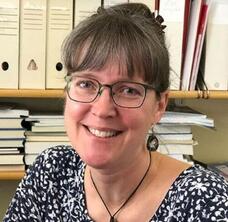
Elisabeth Larsson is a Professor of Scientific Computing at Uppsala University (UU), Sweden and also the Director of UPPMAX, which is the high-performance computing center at UU. She has an MSc degree in Engineering Physics from UU (1994), received her PhD in Numerical Analysis from UU (2000), was postdoctoral fellow at University of Colorado at Boulder (2000-2001), and was recruited back to UU in 2001. Her research interests are centered around computational science tools and interdisciplinary applications. She has made internationally recognized contributions to radial basis function approximation methods and has been part of the development of the modern task parallel programming paradigm. She is Associate Editor of SIAM Journal of Scientific Computing and BIT Numerical Mathematics.
This seminar is co-hosted with the Department of Applied Math. Please contact the host, Prof. Zhao Pan
(zhao.pan@uwaterloo.ca) or David Del Rey Fernandez (ddelreyfernandez@uwaterloo.ca), if any questions
From exoskeletons to legged robots: how human gait
studies can elucidate human-robot interaction
Speaker: Prof. Amy Wu, Queen’s University, ON, Canada
Theme: Robotics, exoskeletons, walking
Time: 2023-Apr-5, 1:00 pm - 2:00 pm
Zoom Meeting ID: 966 7094 8019 (link)
Passcode: MME2022
Summary: A world embedded with robots seems inevitable, from exoskeletons that assist gait to companion robots that help us with activities of daily living. One challenge, however, is designing robots to work with us, not against us. In this talk, I will discuss a few studies that help us understand how to build better robot systems, from exoskeleton controllers to legged robots. I will first discuss some of the challenges in exoskeleton research through the use of a biologically-inspired neuromuscular controller for lower-limb exoskeletons to assist individuals with paraplegia. I will then discuss our recent empirical studies to investigate how healthy individuals maintain stability during gait. We will conclude on how legged robots can affect human gait, even without physical interactions, and what that means for human-robot interaction. Robots have the potential to greatly improve human lives, and we can leverage biomechanics and gait studies to ensure that they are designed to interact well with us.
Prof. Amy R. Wu is an Assistant Professor in the Department of Mechanical and Materials Engineering at Queen’s University and the Mitchell Professor in Bio-inspired Robotics. She is the head of the Biomechanics x Robotics Laboratory (BxRL) and a member of Queen’s Ingenuity Labs Research Institute. Her research interests are at the intersection of biomechanics and robotics with the aim of augmenting legged mobility. Prior to joining Queen’s, she was a postdoctoral researcher in the Biorobotics Laboratory at the Ecole Polytechnique Fédérale de Lausanne (EPFL) in Switzerland and completed her Ph.D. in Mechanical Engineering at the University of Michigan.
please contact the host, Prof. Yue Hu (yue.hu@uwaterloo.ca), if any questions.
CAVITATION - TRANSITION FROM AN ENGINEERING NIGHTMARE TO A TOOL FOR WATER TREATMENT
Speaker: Prof. Matevž Dular, University of Ljubljana, Slovenia
Theme: Fluids and Thermal
Time: 2023-Mar-30th, 12:30 pm-1:30 pm ETD
Zoom Meeting ID: 789 699 0683 (link)
Passcode: MME2023
Abstract: Cavitation - the vaporization and recondensation of a liquid due to a sudden change in local pressure - has been a nuisance for engineers for more than 100 years. We associate it with a drop in the efficiency of turbine machines, vibrations, noise and material erosion. The latter, erosion, was still poorly researched a decade ago and has been the main of my research for more than 10 years. The development of innovative experimental methods has made it possible to advance the understanding of the formation of material damage. In the first part of the lecture, I will show the latest results of these studies. This will be followed by a description of the transfer of knowledge from the field of cavitation erosion to the field of application of cavitation for the destruction of contaminants (bacteria and viruses), which is the central topic of the ERC CABUM project.
Matevz Dular is one of the youngest full professors at the University of Ljubljana, Slovenia. He specializes in fluid mechanics, ultrasound, cavitation and water purification. He has worked at universities in Germany, France and the United States for over 4 years, and has also served as a PI for several projects for the European Space Agency. He has published more than 100 papers and was awarded 9 patents. He gained recognition for his work already in 2017 when his project of water disinfection by hydrodynamic cavitation succeeded to obtain a prestigious European Research Council (ERC) grant. In 2022 he secured a follow-up ERC grant for commercialization of the water treatment technology. In 2019, he was awarded the Zois recognition for his contribution to understanding the phenomenon of cavitation. In 2020 Dr. Dular also became the recipient of the prestigious Friedrich Wilhelm Bessel Research Award from the Alexander von Humboldt Foundation.
Please contact the host, Prof. Zhao Pan (zhao.pan@uwaterloo.ca), if any questions.
Beyond Griffith and Irwin - Using cohesive-zone models
to describe interfacial fracture delamination in singular Stress Fields
Theme: Fracture mechanics, delamination
Time: 2023-Mar-15, 2:30 pm - 3:30 pm
Zoom Meeting ID: 966 7094 8019 (link)
Passcode: MME2022
Summary: The general perception of delamination is that if the interfacial fracture process is embedded within a singular stress field, approaches related to linear-elastic fracture mechanics (LEFM) should work. The only fracture property of the interface that should then be needed is the toughness. Only when the fracture process is extensive (large scale) would other properties of the interface, such as the cohesive strength, be required, as introduced by cohesive-zone models of fracture. This talk will focus on the classes of fracture problems that are controlled by singular-stresses, but which require cohesive-zone descriptions of the interfacial properties. The basic features of cohesive-zone models will be described, and the concept of a cohesive length as an adhesion parameter will be defined. This concept will then be used to explore the mechanics of delamination from corners, and it will be shown why LEFM is such a powerful tool of analysis in the limit of the corner being a sharp crack. It will be shown how cohesive-zone models can be used to describe mixed-mode fracture along bi-material interfaces, and how they rationalize the intellectual difficulties introduced by the oscillating stresses predicted by elasticity theory. It has long been known that timedependent crack growth cannot occur in singular viscous or creeping fields without invoking the notion of a length scale into the description of the fracture process. Cohesive-zone models allow a consistent way of incorporating this feature, and can be used to develop some remarkably simple results for the rupture of a visco-elastic double-cantilever beam with both singular and non-singular fields at the crack tip. Finally, time-dependent fracture processes (such as stress-corrosion cracking, or timedependent damage) in elastic materials can also be described from a cohesive-zone perspective, and compared to classical models of kinetic crack growth.
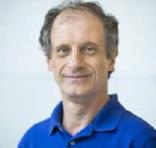
Prof. Michael Thouless is the Janine Johnson Weins Professor of Engineering, and an Arthur F Thurnau Professor, in the Department of Mechanical Engineering at the University of Michigan in Ann Arbor. He read engineering at Churchill College, Cambridge, graduating with a B.A. in 1981, and then did graduate work on the creep of ceramics with Tony Evans at the University of California, Berkeley. After getting his Ph.D. in materials science in 1984, he worked on the fracture of ceramic composites, and on the spalling of coatings and thin films at Berkeley and UCSB. In 1988, he moved to the Physical Sciences Department at IBM in Yorktown Heights as a Research Staff Member, and developed a research program on interface mechanics and the mechanical properties of layered materials. In 1995 he joined the University of Michigan, where he has worked on the fracture of adhesive joints, the mechanical properties of coatings, the mechanics of adhesion and interfaces, and the development of cohesive-zone approaches for interfacial fracture. With collaborators at UM, he has also developed fracture-fabrication techniques for nano-scale devices, and novel design strategies for protection against blast and impact, and for protection against ice adhesion. He has published more than 180 technical papers, and has 12 US and foreign patents. He was awarded an Sc.D. from Cambridge University in 2009, an honorary doctorate, Dr.Techn. (honoris causa), from the Danish Technical University in 2021, the Archie Higdon Distinguished Educator Award from the ASEE in 2015, the Nadai Medal from the ASME in 2021, and the 3M Award for Excellence in Adhesion from the Adhesion Society in 2023. He was elected an Overseas Fellow at Churchill College Cambridge in 2011 and 2017, and selected as an Otto Mønsted Guest Professor at the Danish Technical
University in 2013 and 2021.
Please contact the host, Prof. Yue Hu (yue.hu@uwaterloo.ca), if any questions.
SAND AND WATER (REMIX)
Speaker:Prof. Stéphane Dorbolò, Université de Liège (Belgium) and F.R.S.-FNRS
Theme: Fluids, Thermal, and Solids
Time: 2023-Feb-23, 3:00 pm-4:00 pm ETD
Zoom Meeting ID: 789 699 0683 (link)
Passcode: MME2023
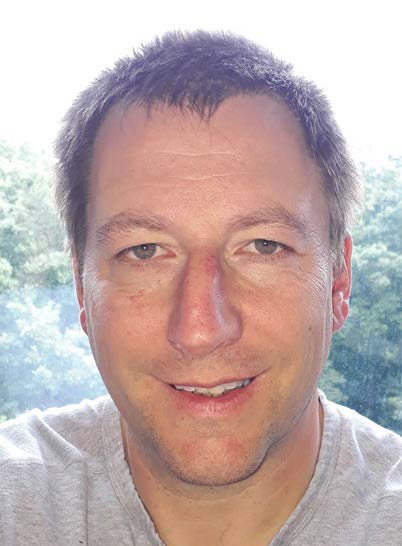
Abstract: Mixing grains with a fluid is as old as the beer discovery. Most often then not, the volume ratio between the grains and the liquid is close to 1:1 like in bread dough, concrete, mud… During this talk, we will be interested by particular mixings for which one of the components is in small quantity compared to the other. In the first part, we will describe two situations. (i) The impact of a droplet on a granular surface which is typically observed when it rains on a dry beach. The spreading of the droplet is constrained by the adsorption of grains at its surface. (ii) The impact of a single grain on a wet granular material which is typically the easiest way to build a sand castle. The impacting dry grains can be captured by the surface humidity of the wet granular material. This capturing process induces the generation of grain towers built grain by grain. In the second part, we will consider the Leidenfrost effect. This effect is obtained when a droplet is released on a smooth and solid surface heated beyond the boiling temperature of the liquid. If the temperature is sufficient, the droplet levitates on its own vapour conferring to a droplet perfect non-wetting conditions. (i) First, a small quantity of grains is added. The grains are trapped by the interface forming a monolayer of grains surrounding the levitating droplet. Armoured droplets are obtained. (ii) In the second step, the droplet is released on a large assembly of heated grains which is unfavourable regarding the Leidenfrost effect. Under given conditions, we observed that the droplet starts digging the granular material. This effect is due to a particular case of the eidenfrost effect.
Stéphane Dorbolo is an F.R.S.-FNRS research associate and an associate professor at the Université de Liège (Belgium). He received his Ph.D from the University of Liège in 2000 for his thesis concerning the thermal properties of the high-Tc superconductors at the SUPRAS laboratory. Then, he started a post-doc at the GRASP group about the electrical properties of granular material and was a visiting scientist at ARC (Cambridge), Collège de France, Clark University and ENS-Lyon extending his field of research to droplets, anti-bubbles and granular materials in general.
Please contact the host, Prof. Zhao Pan (zhao.pan@uwaterloo.ca), if any questions.
ROBOTS THAT LEARN TO INFLUENCE HUMANS
Speaker: Prof. Dylan Losey, Virginia Tech, USA
Theme: Robotics, Interaction
Time: 2023-Feb-8, 1:00 pm - 2:00 pm
Zoom Meeting ID: 966 7094 8019 (link)
Passcode: MME2022
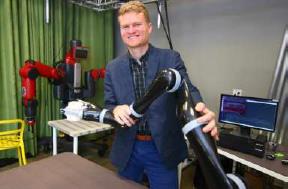
Summary: Our society is rapidly developing interactive robots that collaborate with humans, e.g., self-driving cars near pedestrians, surgical devices with doctors, and assistive arms for disabled adults. The humans who interact with these systems will not always be experts in robotics: so how should we facilitate mutual understanding between everyday users and learning agents? My talk will examine this question from two perspectives: the robot’s and the human’s. From the robot’s point-of-view, I will formalize algorithms that learn to interpret low-dimensional human inputs for controlling robot arms. From the human’s point-of-view, I will leverage multimodal feedback to reveal what the robot has learned and when the robot is uncertain. When viewed together, these perspectives enable robots to learn to influence human partners towards coordinated and emergent behaviors.
Prof. Dylan Losey is an assistant professor in Mechanical Engineering at Virginia Tech. His research interests lie at the intersection of human-robot interaction, learning, and control. Specifically, he develops algorithms that enable robots to personalize their behavior for human collaborators. Dylan was previously a postdoctoral scholar at Stanford University. He earned his doctoral degree in Mechanical Engineering from Rice University in 2018 and his bachelor’s degree in Mechanical Engineering from Vanderbilt University in 2014. Dylan has received Best Paper awards from the Conference on Robot Learning and the IEEE/ASME Transactions on Mechatronics.
UWaterloo MME Departmental Seminar Series
New Roles and Tools for Combustion in Battery Research
Speaker: Prof. Sili Deng, MIT, USA
Theme: Energy, Combustion
Time: 2023-Jan-27, 2:00 pm - 3:00 pm
Seminar location* Mike & Ophelia Lazaridis Quantum-Nano Centre (QNC) 1501
Summary: Combustion has played a vital role in energy conversion and can contribute to energy storage and sustainability by assuming a new role in manufacturing. For example, flame-based spray methods have great potential in manufacturing lithium-ion battery (LIB) cathode materials due to their features such as continuous, fast, and scalable operation. By reducing the cost and improving the performance of LIBs, such manufacturing methods will facilitate their applications in transportation electrification and grid energy storage. In this talk, a flame-assisted spray pyrolysis technology will be introduced together with examples on utilizing this approach to control the morphology and performance of LIB cathode materials with incredibly short synthesis time compared to the traditional methods. On the other hand, applying tools developed in other disciplines to combustion research could provide us new perspectives and enable new discoveries. I will demonstrate our recently developed Chemical Reaction Neural Network approach to identify reaction pathways and simultaneously quantify kinetic parameters from data without any prior knowledge of the chemical system. Specifically, I will discuss the challenges in developing such an approach, successful case studies in energy conversion and biochemistry, and future opportunities.
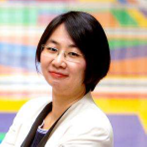
Summary: Combustion has played a vital role in energy conversion and can contribute to energy storage and sustainability by assuming a new role in manufacturing. For example, flame-based spray methods have great potential in manufacturing lithium-ion battery (LIB) cathode materials due to their features such as continuous, fast, and scalable operation. By reducing the cost and improving the performance of LIBs, such manufacturing methods will facilitate their applications in transportation electrification and grid energy storage. In this talk, a flame-assisted spray pyrolysis technology will be introduced together with examples on utilizing this approach to control the morphology and performance of LIB cathode materials with incredibly short synthesis time compared to the traditional methods. On the other hand, applying tools developed in other disciplines to combustion research could provide us new perspectives and enable new discoveries. I will demonstrate our recently developed Chemical Reaction Neural Network approach to identify reaction pathways and simultaneously quantify kinetic parameters from data without any prior knowledge of the chemical system. Specifically, I will discuss the challenges in developing such an approach, successful case studies in energy conversion and biochemistry, and future opportunities.
Dr. Sili Deng received her doctoral degree in Mechanical and Aerospace Engineering from Princeton University. After being a postdoctoral scholar in the Department of Mechanical Engineering at Stanford University, she joined the Department of Mechanical Engineering at MIT as an assistant professor in 2019. Her research focuses on energy conversion and storage, specifically, the fundamental understanding of combustion and emissions, physics-informed datadriven modeling of reacting flows, carbon-neutral energetic materials, and flame synthesis of materials for catalysis and energy storage. At MIT, Dr. Deng received the d’Arbeloff Career Development Chair in 2019 and Class of 1954 Career Development Chair in 2022. Dr. Deng also received the Bernard Lewis Fellowship from the Combustion Institute in 2016 and NSF CAREER Award in 2022.
*NOTE: this is a joint seminar with the Waterloo Institute for Nanotechnology (WIN) and will be hosted in person. Register here for the event: https://uwaterloo.ca/institute-nanotechnology/events/win-andmme-joint-seminar-new-roles-and-tools-combustion
Please contact the host, Prof. Yue Hu (yue.hu@uwaterloo.ca), if any questions
SIMULATION AND MODELING OF TURBULENT PARTICLE-LADEN FLOWS
Speaker: Prof. Jesse Capecelatro, University of Michigan, USA
Theme: Fluids and Thermal
Time: 2023-Jan-16, 1:00 pm-2:00 pm ETD
Zoom Meeting ID: 789 699 0683 (link)
Passcode: MME2023
Abstract: Many natural and industrial processes involve the flow of solid particles or liquid droplets whose dynamical evolution and morphology are intimately coupled with a carrier gas. The nonlinear and multiscale nature of such flows often precludes a direct analytic or numerical solution, and instead we must turn to simulations that rely on subgrid-scale models. The first part of this talk will focus on the flow physics taking place at the microscale (scale of individual particles). A new stochastic drag formulation will be presented that is designed to capture the effect of particle microstructure on velocity statistics. We will then focus on larger systems containing many interacting particles. I will show how strong interphase coupling spontaneously generates dense clusters that impact the underlying turbulence. The role of clusters on heat transfer under conditions relevant to chemical transformation reactors will also be presented.
Jesse Capecelatro is an Associate Professor in the Departments of Mechanical Engineering and Aerospace Engineering at the University of Michigan. He received a Ph.D. from Cornell in 2014. Prior to joining the University of Michigan in 2016, he was a postdoc at the University of Illinois Urbana-Champaign. He is a recipient of the NASA Early Stage Innovations Award, NSF CAREER Award, ONR Young Investigator Award, and the ASME Pi Tau Sigma Gold Medal Award. His research is broadly under the realm of fluid mechanics, with an emphasis on multiphase flow, turbulence, reacting flows, and high-performance computing.
Please contact the host, Prof. Zhao Pan (zhao.pan@uwaterloo.ca), if any questions
Waterloo MME Departmental Seminar Series
GPU Acceleration for Real-Time, Whole-Body, Nonlinear Model Predictive Control
Speaker: Prof. Brian Plancher, Barnard College, Columbia University, USA
Theme: Robotics, Control, Optimization
Time: 2022-Nov-21, 1:00 pm - 2:00 pm
Zoom Meeting ID: 966 7094 8019 (link)
Passcode: MME2022
Summary: Whole-body, nonlinear model predictive control (MPC) has been referred to as the "Holy Grail" of robot motion planning and control, as it can enable robots to dynamically compute optimal trajectories and adapt to changes in their environment. Unfortunately, the underlying trajectory optimization algorithms traditionally used to solve these problems are computationally expensive and often too slow to run in real-time. Compounding this issue, the impending end of Moore's Law and the end of Dennard Scaling have led to a utilization wall that limits the performance a single CPU chip can deliver, requiring computer scientists to look beyond the CPU to exploit large-scale parallelism available on alternative computing
platforms such as GPUs. This talk charts a path towards addressing these challenges by exposing, analyzing, and leveraging the structured sparsity and parallelism patterns found in the numerical optimization and rigid body dynamics algorithms commonly used for whole-body, nonlinear MPC. Through careful algorithmic refactoring and re-design, this work exploits these patterns to enable real-time MPC performance through GPU-acceleration.
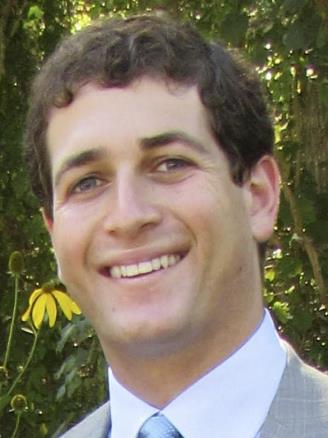
Prof. Brian Plancher is an Assistant Professor of Computer Science at Barnard College, Columbia University where he leads the Accessible and Accelerated Robotics Lab (A²R Lab). He also co-chairs the Tiny Machine Learning Open Education Initiative (TinyMLedu) and is an associate co-chair for the IEEE RAS TC on Model Based Optimization for Robotics. His research is focused on developing and implementing open- source algorithms for dynamic motion planning and control of robots by exploiting both the mathematical structure of algorithms and the design of computational platforms. As such, his research is at the intersection of Robotics and Computer Architecture, Embedded Systems, Numerical Optimization, and Machine Learning. He also wants to improve the accessibility of STEM education. As such, he researches ways to better understand and improve diversity, equity, inclusion, and belonging in STEM education globally, as well as designs and teaches new interdisciplinary, project-based, open-access courses that lower the barrier to entry of cutting edge topics like robotics and embedded machine learning.
Please contact the host, Prof. Yue Hu (yue.hu@uwaterloo.ca), if any questions.
TURBULENCE STRUCTURE AND MODELING IN THE FREQUENCY DOMAIN
Speaker: Prof. Tim Colonius, Caltech, USA
Theme: Fluid Mechanics
Time 2022-Nov-7, 11:00 am-12:00 pm ETD
Zoom Meeting ID: 789 699 0683 (link)
Passcode: MME2022
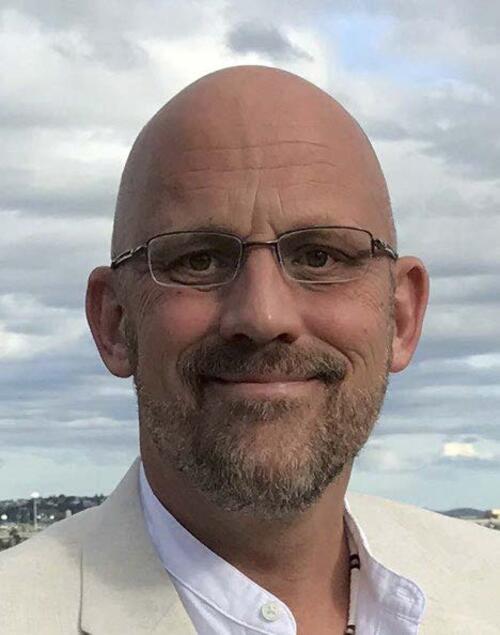
Abstract: Amongst many available data-driven modal decompositions of utility in fluid mechanics, the frequency-domain (spectral) version of the proper orthogonal decomposition (SPOD) plays a special role in the analysis of stationary turbulence. SPOD modes are optimal in expressing structures that evolve coherently in both space and time, and they can be regarded as optimally averaged DMD modes. Importantly, the SPOD spectrum is also related to the resolvent spectrum of the linearized dynamics and examination of the relationships between the SPOD and resolvent modes yields information about how coherent structures are forced by nonlinear interactions amongst coherent and incoherent turbulence. We discuss the application of these tools to analyze and model turbulence in high-speed jets and boundary layers. We highlight recent developments including (a) utilizing eddy-viscosity models in resolvent analysis to enable RANS-based prediction of coherent structures, and (b) nonlinear extensions of resolvent analysis to discover worst-case disturbances for laminar-turbulent transition, and (c) the development fast spatial marching methods for large-scale resolvent problems.
Tim Colonius is the Frank and Ora Lee Marble Professor of Mechanical Engineering at the California Institute of Technology. He received his B.S. from the University of Michigan in 1987 and M.S and Ph.D. in Mechanical Engineering from Stanford University in 1988 and 1994, respectively. He and his research team use numerical simulations to study a range of problems in fluid dynamics, including aeroacoustics, flow control, instabilities, shock waves, and bubble dynamics. Prof. Colonius also investigates medical applications of ultrasound and is a member of the Medical Engineering faculty at Caltech. He is a Fellow of the American Physical Society and the Acoustical Society of America. He was the recipient of the 2018 AIAA Aeroacoustics Award, and the 2021 Stanley Corrsin Award from the American Physical Society.
UWaterloo MME Departmental Seminar Series
TURBULENCE STRUCTURE AND MODELING IN THE FREQUENCY DOMAIN
Speaker: Prof. Tim Colonius, Caltech, USA
Theme: Fluid Mechanics
Time: 2022-Nov-7, 11:00 am-12:00 pm ETD
Zoom Meeting ID: 789 699 0683 (link)
Passcode: MME2022
Abstract: Amongst many available data-driven modal decompositions of utility in fluid mechanics, the frequency-domain (spectral) version of the proper orthogonal decomposition (SPOD) plays a special role in the analysis of stationary turbulence. SPOD modes are optimal in expressing structures that evolve coherently in both space and time, and they can be regarded as optimally averaged DMD modes. Importantly, the SPOD spectrum is also related to the resolvent spectrum of the linearized dynamics and examination of the relationships between the SPOD and resolvent modes yields information about how coherent structures are forced by nonlinear interactions amongst coherent and incoherent turbulence. We discuss the application of these tools to analyze and model turbulence in high-speed jets and boundary layers. We highlight recent developments including (a) utilizing eddy-viscosity models in resolvent analysis to enable RANS-based prediction of coherent structures, and (b) nonlinear extensions of resolvent analysis to discover worst-case disturbances for laminar-turbulent transition, and (c) the development fast spatial marching methods for large- scale resolvent problems.
Tim Colonius is the Frank and Ora Lee Marble Professor of Mechanical Engineering at the California Institute of Technology. He received his B.S. from the University of Michigan in 1987 and M.S and Ph.D. in Mechanical Engineering from Stanford University in 1988 and 1994, respectively. He and his research team use numerical simulations to study a range of problems in fluid dynamics, including aeroacoustics, flow control,instabilities, shock waves, and bubble dynamics. Prof. Colonius also investigates medical applications of ultrasound and is a member of the Medical Engineering faculty at Caltech. He is a Fellow of the American Physical Society and the Acoustical Society of America. He was the recipient of the 2018 AIAA Aeroacoustics Award, and the 2021 Stanley Corrsin Award from the American Physical Society.
Please contact the host, Prof. Zhao Pan (zhao.pan@uwaterloo.ca), if any questions.
COMPUTATIONALLY DESIGN SUSTAINABLE MORPHING MATTER
Speaker: Prof. Lining Yao, Carnegie Mellon University (CMU), USA
Theme: Morphing Matter, Sustainability
Time: 2022-Oct-06, 11:00 am - 12:00 pm
Zoom Meeting ID: 966 7094 8019 (link)
Passcode: MME2022
Summary: A significant contributor to climate disaster is the way we make, grow and consume physical things. Sustainable morphing matter is defined as physical materials and structures that dynamically reconfigure in shapes and functions in response to natural and ambient energy stimuli. Unlike electronic sensors and motors, the dominant machine components for “motion” and “function” in today’s autonomous and robotic systems, sustainable morphing matter systems are often biodegradable and triggered by electricity-free energy stimuli, yet programmed to be adaptive, responsive, and intelligent. To elaborate many ways bio-inspired and bio- hybrid morphing systems can contribute to the global sustainability effort, the director of the Morphing Matter Lab, Dr. Lining Yao will present a few morphing systems that hold promise to contribute to sustainable agriculture, environmental conservation, and manufacturing. Prof. Lining Yao is the Cooper-Siegel Assistant Professor of the Human-Computer Interaction Institute at Carnegie Mellon University (CMU), School of Computer Science, directing the Morphing Matter Lab (morphingmatter.cs.cmu.edu). Lining also holds courtesy appointments at Mechanical Engineering and Material Sciences and Engineering at CMU. Morphing Matter lab develops processes, materials, mechanisms, tools, and applications of adaptive, dynamic, and intelligent morphing materials from nano to macro scales. Research often combines computational fabrication, material engineering, mechanics and geometry studies, as well as human- or nature- centered design processes. The mission is to advance both science and society with the design of morphing matter. Lining gained her Ph.D. from the MIT Media Lab. She is the co-founder of MorphingMatter4Girls Initiative, a Wired UK fellow, an appointed Instructor by the United Nation Industrial Development Organization, a CMU Provost's Inclusive Teaching Fellow, and a recipient of the NSF CAREER Award.
Please contact the host, Prof. Yue Hu (yue.hu@uwaterloo.ca), if any questions.
SECURING CRITICAL MATERIALS FOR EMERGING ENERGY TECHNOLOGIES IN THE U.S.
Speaker: Dr. Chukwunwike (Nwike) Iloeje, Principal Scientist
Energy Systems & Infrastructure Analysis (ESIA) Division, Argonne National Laboratory, U.S.
Theme: Energy, Materials, Manufacturing
Time: 2022-Sept-26, 10:00-11:00 am EST
Zoom Meeting ID: 789 699 0683 (link)
Passcode: MME2022
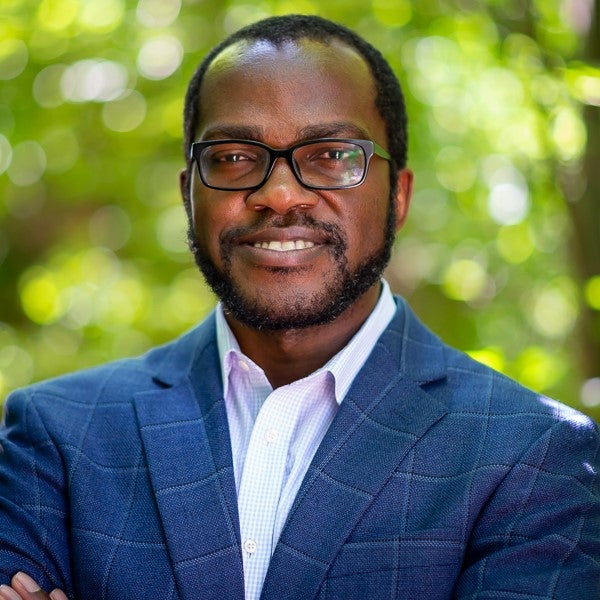
Summary: Critical materials such as rare earth underpin technologies needed for a decarbonized global economy. Critical materials – like rare earth elements – are essential to emerging energy technologies that underpin the US decarbonization goals. Despite having vast mineral resources, the US has limited operational mining and refining capacity, leading to net import reliance and consequent supply vulnerabilities. Secondary recovery can mitigate the supply risks and enable a circular economy for critical materials. However, feasibility depends on the technical performance, energy, economic and environmental footprint of the recovery technology when deployed at scale.
In this talk, I will give an overview of the challenge of material criticality, and the potential of secondary recovery to mitigate supply risks. Then I will show how we can address the question of feasibility with simulation and mathematical optimization, addressing the problem at various scales from process fundamentals to reverse logistics.
Dr. Nwike Iloeje is a principal scientist in the ESIA division at Argonne, and the strategic analysis group Co-Lead for the DOE-advanced manufacturing office. In his research, he uses computational modeling to explore questions at the intersection of sustainable energy conversion and material transformations, with particular interest in critical materials, carbon capture and utilization. He has a PhD from Massachusetts Institute of Technology, and Bachelors’ from the University of Nigeria, both in Mechanical Engineering.
SECURING TWO PROBLEMS IN DATA ASSIMILATION FOR THE SHALLOW WATER EQUATIONS
Speaker: Nicholas Kevlahan, McMaster University
Theme: Fluid Mechanics, Data Science
Time: 2022-Oct-25, 10:00-11:00 am EST
Zoom Meeting ID: 947 9123 3531 (link)
Passcode: 998101
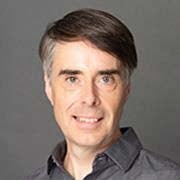
Summary: The shallow water equations (SWE) are a widely used model for the propagation of surface waves in oceans, lakes and rivers. Common applications include modelling the propagation of tsunami waves, storm surges and flooding. In this talk we describe two data assimilation problems for the SWE, both based on sparse observations of the free surface height. The goal of the first problem is to reconstruct the initial conditions for a surface wave. In the case of the relatively simple linear one-dimensional problem we prove a theorem that gives sufficient conditions on the number and spacing of the observations that ensure convergence to the true initial conditions. These results are confirmed numerically for the nonlinear equations. We then consider the associated two-dimensional nonlinear problem. We compare observations arranged in straight lines, in a grid, and along concentric circles, and determine the optimal number and configuration of observation points such that convergence to the true initial conditions is achieved. In the second (ill posed) problem our goal is to determine under which conditions observations of the free surface are sufficient to reconstruct the bathymetry to a given accuracy (e.g. sufficient for modelling wave propagation). We use density-based global sensitivity analysis (GSA) to assess the sensitivity of the surface wave and reconstruction error to model parameters and second order adjoint analysis (SOA) to derive the sensitivity of the surface wave error, given the reconstructed bathymetry, to perturbations in the observations.
Nicholas Kevlahan is a Professor in the Department of Mathematics and Statistics at McMaster University. He has a BSc from the University of British Columbia, a PhD from the University of Cambridge and was a Marie Curie post-doctoral fellow at École Normale Supérieure (Paris). He has been an invited professor at Université Grenoble-Alpes, INRIA, École Normale Supérieure (Paris), École Polytechnique (Paris), and a visiting researcher at the University of Cambridge. His interdisciplinary research program is focused on advanced mathematical and computational methods for fluid dynamics problems from physics and engineering. Current research includes developing the WAVETRISK code for dynamically adaptive climate modelling, data assimilation techniques, fluid-structure interaction and compressive sampling. He has an active research group of PhD, MSc and BSc students from a wide diversity of backgrounds.